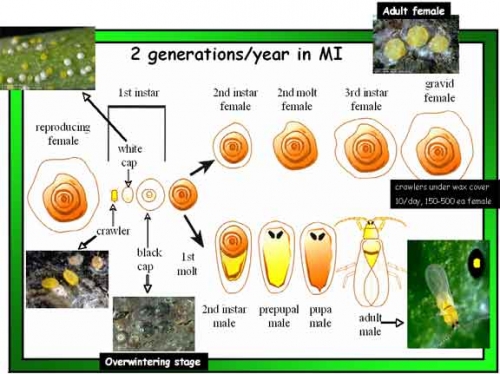Time for San Jose scale
Editor’s note: This article is from the archives of the MSU Crop Advisory Team Alerts. Check the label of any pesticide referenced to ensure your use is included.
We have observed large populations of San Jose scale on sweet cherries in the northwest, but these pests are showing up on tree fruit across the state. Sweet cherries are considered hosts of these introduced pests, but more commonly, we see San Jose scale in apple, peach, pear and plum. Scales are unusual insects with a very unique life cycle that makes them difficult to control. Adult females live underneath a waxy, turtle-like covering, giving birth to live young rather than lay eggs—these nymphs are the crawler stage of the life cycle. Because the crawler’s stage does not posses any waxy covering, this is one optimal stage for control. Crawler females will develop wax coverings; males develop wings for dispersal (Figure 1).
Figure 1. San Jose scale biology.
San Jose scale feed on tree sap, and a large population is needed to cause injury. Depending on the size of the population, scale can kill a young tree in two to three years. Older trees can also be killed by scale, but they do withstand more feeding damage than young trees. In addition to bark feeding, San Jose scales can also feed on the fruit and leaves. The feeding on fruit is the most conspicuous where scales cause bright red spots, most commonly seen on apple.
San Jose scale spend the winter as partially grown scales where they adhere themselves tightly to the bark. When the sap begins to run in the spring, the scales grow, and they reach full grown status in late May. At this time of the year, male scales come out from under the scale to mate with females. Females will start to produce young, and are each capable of bearing 150-500 offspring. These crawlers start to suck sap with their needle-like mouthparts. In three weeks, the young crawlers molt and lose their old skins, legs, and antennae to become a flattened sac with waxy caps (Figure 1). They remain attached to the trees with their mouthparts.
Because these insects have two generations per year, we have two optimal timings for control. An oil application during pre-bloom is highly effective at targeting adults. Insecticides applied mid-June and mid-August target crawlers before they mate. Table 1 and Figure 2 list the insecticidal activity of several compounds in research conducted at the Trevor Nichols Research Center.



 Print
Print Email
Email







